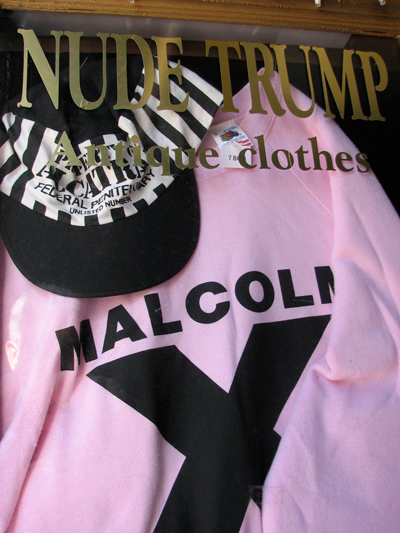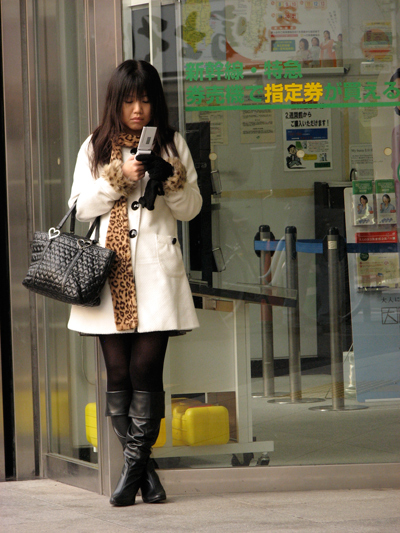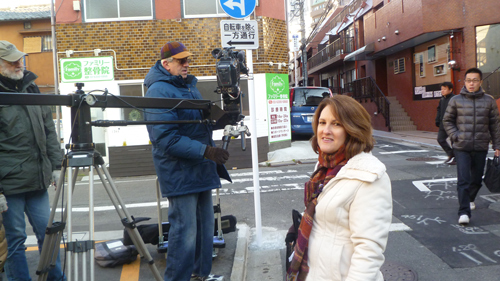
Our flight to Japan on Virgin Atlantic is half-empty and quite comfortable. Virgin’s Premium Economy seats, which our travel agent says were not much more expensive than standard Economy, provide better food, better seats, better video, and more legroom.
Our flight leaves London at 1 pm Sunday. Twelve hours later, after flying nearly 6000 miles east across nine time zones, we arrive at Narita Airport outside Tokyo, where, somehow, it’s 10 am Monday. In San Francisco it’s still 5 pm Sunday, 17 hours earlier than Tokyo. None of us sleep much on the plane. The time change has us oddly discombobulated. Our midday departure and the availability of hundreds of movies (we’re all film buffs) both mitigate against sleep, as does, oddly, our enjoyment of the extra comfort on this flight.

We collect our bags, stop at Japanese Customs for the usual carnet ritual, then meet our production assistant Rie, and our driver from Virgin Earth Inc, a production services company we have used several times as our local representatives in Tokyo. They have brought a gigantic van, really a small bus, for us and our gear and luggage: about ten seats in the front, and a huge cargo area in the rear. Without the cargo area, it could seat 30 people. Easily.
We check into the Tokyo Hilton in Shinjuku in the heart of the city. By now it’s 1 pm. The best way to combat jetlag is to get your body clock on the new time as soon as possible, and stay on it. Determined to remain awake until the local version of evening, we trudge 10 minutes through the streets of Tokyo to Shinjuku Station, where we find a variety of restaurants, including a small tempura place to sate our yen (tempurarily) for Japanese food.


Randy must return to the hotel to work, but I lead Lori and Jim through the labyrinthian station. This is my 11th visit to Japan, and even though I’m still just a henna gaijin (crazy foreign barbarian), I can find my way around the main downtown areas. We take a train on the Yamanote line about a dozen stops to Yurakucho Station and the Ginza district, the upscale shopping/commercial area, walk around aimlessly for a while, get slightly, briefly lost, look in at a Sony office, stop at Starbuck’s, then head down another street, roughly back toward the station.



The streets are filled with Japanese hurrying from one place to another, including many stylishly dressed school kids and young adults, often in high boots. The odd mixture of graphics on signage here always fascinates me, often combining elements of Japanese writing, fractured English sentences, photographic images, and cartoony characters, or American celebs endorsing odd products. It’s sunny and cold this afternoon, with a biting wind. The weather stays like this for our whole visit to Japan. Temps in the 30s.


We are getting pretty exhausted, but we don’t want to go to sleep too early, for fear we’ll wake up in the middle of the night. We’re still buzzing over the latest news about the Tucson shootings, the backbiting about Palin’s crosshairs, her publicist claiming they’re just “map symbols,” like surveyors’ marks.
Then, on this route we’ve chosen by chance, we see a familiar logo: a glowing white apple, missing a bite. We’re curious to know how much iPhones sell for here, so we stop in to browse. Soon a female voice calls out: “Jimmy?” and a young Japanese woman with red hair comes up and gives Jim a hug. Turns out she’s an Apple Store employee here who recently worked with Jim in Cupertino as a hand model, on a long shoot for the fruity computer-and-life-style products company.
Talk about random!

Next day, we meet our patient, whom I’ll call Nishikawa-san, and scout locations. We have arranged through Richard Kipnis, our production manager for Virgin Earth, to rent an apartment for a day’s shooting in a home-type environment. As in England, we also rent our lighting and grip gear here in Tokyo and hire some local crew people: gaffer Miyajima, gaffer’s assistant Kamijima, propmaster Misa, data manager Drew. Miyajima joins us and we scout at the apartment, as well as at a Karaoke club, where we walk down surreal, colorful corridors to choose a room to rent, so we can shoot a scene of our patient out relaxing with friends.


Our last scheduled scout is at a sleep clinic, where we find ourselves subject to severe restrictions of availability and helpfulness. The “conference room” space they have arranged for us to shoot our interviews is actually a small desk and chair in the middle of an active office. We are a bit taken aback. Knowing how small offices are in Japan, we were expecting to be shown a small space, perhaps 10×15 or even 9×12. But this is less than 6 feet square, surrounded by people on the phone, conducting business.
We decide to rent a Japanese-style room at our hotel, the Hilton, for our interviews, so we rush there to examine a suitable room, then grab dinner that night at an overpriced, under-attended sashimi place in the basement mall attached to our hotel.


Our story in Japan is about sleep apnea, a subject close to my heart since my own diagnosis with this condition nearly two years ago. After a friend’s son in his 20s passed away of complications from sleep apnea, I shook off my fog of denial and went to the doctor. I was sleeping terribly, anyway, waking up every hour or two most nights. In my initial interview in the pulmonary department at Kaiser, they told me that if I slept badly, snored and stopped breathing during the night (as my dear wife had told me for years), I had sleep apnea. By definition.
A sleep test confirmed the finding, and they quickly hooked me up with a CPAP machine. This Continuous Positive Airway Pressure machine is a black box, about the size of a small box of tissues, plus a flexible hose and mask. I’ve used it every night since then, except for the scattered nights I’ve been incarcerated on airplanes. It pumps air continuously (hence the name) into my nose and mouth, in order to keep the airway open down in my throat. This eliminates snoring (which, in my layman’s understanding, is caused by the airway opening and closing roughly during inhalation and exhalation). With the CPAP, if my body “forgets” to breathe, the air is forced into my lungs. And my sleep is much improved, even when jetlagged. Using it isn’t a burden. I look forward to its soothing effect at bedtime.

Sleep apnea hasn’t held me back. The machine and apparatus are portable and can use any electrical voltage, and I always bring an extension cord and plug adaptors when traveling abroad. I’ve used my CPAP in hotels on three separate trips to Europe, three to Latin America, and three to Asia, and various cities in the US. Plus, as “personal medical equipment,” it doesn’t count as a carry-on, at least in the US, where the TSA folks are trained to recognize the CPAP.
The night after our scout, on Richard’s recommendation, we venture out into the cold windy weather to eat at Ototo, a fancy-schmancy two-story place in the Shinjuku Center building near the Hilton. Japanese food of various kinds, delicious and well-presented, if a bit bird-nesty, trendy and pricey. And we couldn’t resist: “Ototo! We’re not in Kansas any more.”
I’ve googled this restaurant since then. Here’s the Google Translate text of a recent review of Ototo from the Japanese: “Satisfied with the money! It is a shop. This content, if the service accept this amount? What seems. The taste of the dishes are, of course, they also clever choice of dishes, also safe and loved ones to take me to the company’s boss! I think shops. The cuisine, of course superb, but the delicious variety, and a last pot of rice is an absolute loss I gotta go eat.”

Our shoot in Japan starts the next morning, when we meet our crew on a street corner in the Yoyogi district. We set up our camera (the Panasonic 3700 supplied by Jim’s company, Videofax in San Francisco) on another locally rented jib arm, this one made by Lowel and much longer than the Manchester Stub.

We take a few establishing shots of the neighborhood, an area of private homes and small apartment buildings, then head inside to the sleep clinic for an hour, to shoot three scenes before they open: sleep testing, consultation, and dissemination of information. Because we are severely limited in our access and time, we must shoot these scenes hurriedly by available light, flat and shapeless, but Randy will strive to improve them later with post-production color correction.
After the clinic, we move back to the Hilton and set up to interview an eminent sleep doctor from the clinic, in the room we’ve rented for this purpose. He tells us of the dangers of sleep apnea, and its association with lowered blood oxygen level and various pulmonary and cardio-vascular problems. Randy and Richard and I run out from there to shoot several scenes on the street and on the commuter trains with our patient, recreating visually his disorientation caused by sleep deprivation, before beginning CPAP treatment.
It’s great to work with Richard. A native of San Diego, he has lived in Japan for many years and understands the shooting needs of foreign crews. Virgin Earth is his company, and his technical knowhow and producer skills make him a terrific asset. We also love teasing him, pointing out several times that our San Francisco Giants overtook and finally defeated his San Diego Padres in the closing days of the last baseball season, after the Padres lost ten games in a row.

That night, Richard guides us toward a sushi joint in the basement of a bus terminal near Shinjuku Station. Here we sit at a huge counter as freshly made sushi dishes pass us by on a continuous belt. The price of each dish is keyed to the color of the plate, and we quickly stuff ourselves with fabulous food. A Japanese family nearby has been watching and smiling as we guzzle raw fish. They come over to say hello as they are leaving. “You like sushi?” asks the dad with a big smile, and we realize we are the only gaijin in the place.

Many of the dishes are recognizable or identifiable by using the photo menu. But one dark red slab of sashimi on rice eludes us. Someone thinks it might be horse, but I’ve seen (and once eaten) horse sashimi, and it was very cold, nearly frozen, and nicely marbled, not deep red like this. Next day, Richard tells us it was whale sashimi, and the odd pink meat with white edges was not pork but whale bacon. Both are still legal, as Japan, under international treaties, still kills whales for scientific and research purposes, and sells the meat.
Next morning, we load into our rented apartment, which is long and narrow, very modern and sleek. Situated on an island in Tokyo Bay, it provides killer views in three directions. Randy and Jim set up our second camera (Randy’s Sony PMW-EX3 XDCAM EX HD Camcorder) to shoot some time-lapse intervalometer footage of the changing skyline, while I set up the main camera, with the EyeDirect mirror contraption for our interviews. See Taming the Wild Eyeline [1] for more about the EyeDirect.

We interview an executive from our client company. I learn that, three years earlier, they acquired the company that makes my CPAP. The exec tells of the need for sleep studies and research in sleep apnea in Japan.
We interview our patient, Nishikawa-san, and he is upbeat and positive. He describes his own saga; how for years his wife and son worried that he snored and stopped breathing during the night, how his sleep patterns had deteriorated until he was exhausted all day, how he finally agreed to get tested after passing out in a taxi. Now he never misses a night with the CPAP, sleeps through till morning, and has improved his outlook on life. And he is able to do it all at home.
We shoot a few quick still life scenes of homey images in the apartment, then dash across town to the Karaoke club where we have arranged to rent a room for two hours. Most Karaoke places in Japan rent out separate rooms to parties of various sizes, rather than providing an open bar scene with strangers. In our allotted time, we must load in through the funny corridors, set up and light a scene with Nishikawa and eight friends, then shoot and wrap out before we run into overtime on the room. Lori has worked hard to negotiate a decent rate for the rental, and we don’t want to overstay.
Our shoot is almost over, and we are struck by similarities in our two subjects, Tim and Nishikawa, each working hard to overcome physical obstacles and limitations with heart-warming optimism. Both are being treated at home, not in a hospital. Both our shoots are ending with charming, typical scenes of socializing and companionship, first in a Manchester pub, and now in a Tokyo Karaoke club.

Our Japanese lighting crew lights the Karaoke scene quickly. We use mostly Kino-Flo lights with colored “party gels” — reds, blues, purples — and quickly create a moody, colorful, night-club-like effect. With musical accompaniment, Nishikawa-san amazes and surprises us with a terrific version of Louis Amstrong’s “What a Wonderful World” in an accurate, rumbly-growly bass Satchmo voice:
I see trees of green, red roses too
I see them bloom for me and you
And I think to myself, what a wonderful world.
I see skies of blue and clouds of white
The bright blessed day, the dark sacred night
And I think to myself, what a wonderful world.
The colours of the rainbow, so pretty in the sky
Are also on the faces of people going by
I see friends shakin’ hands, sayin’ “How do you do?”
They’re really saying “I love you.”

And with that, it’s a wrap.
TO BE CONTINUED



